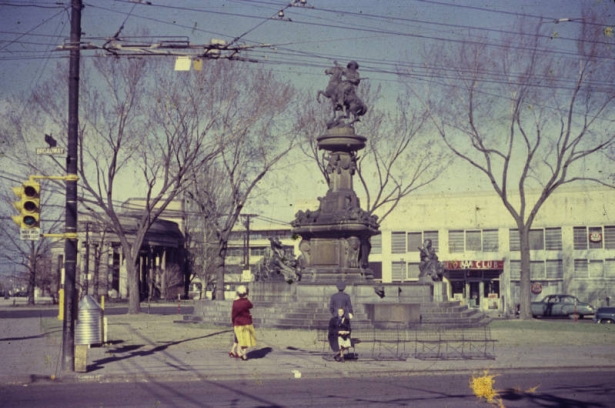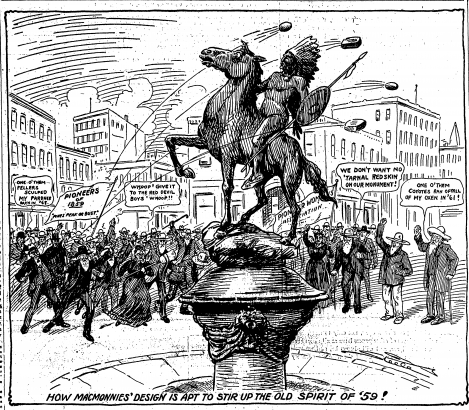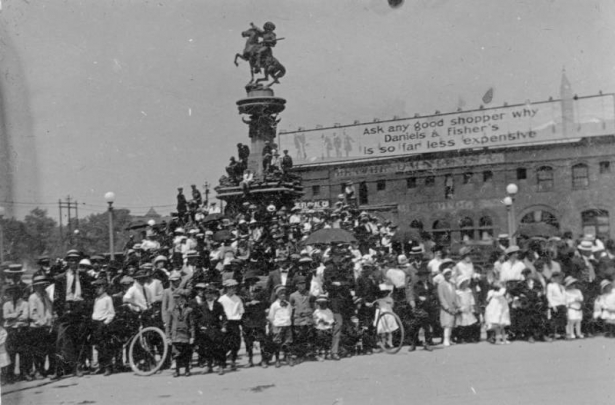Denver’s Pioneer Monument, a sculpture-adorned fountain at the intersection of Broadway and Colfax, was erected in 1911 as a display of Denver’s place in the intensely complex migration branded as “Manifest Destiny.” This symbol, born of aspirational memory-making and established half a century after the city it hailed, immediately became a source of controversy and concern about public art, pioneers, and the nature of the American West.
The American Indian Movement of Colorado has pushed for years to remove the statue of Kit Carson at the top of the monument, describing his continued memorial as “erasing ‘the existence and histories of indigenous peoples and nations.’” Carson’s most controversial (though certainly not his only controversial) actions took place during his military years. He implemented a scorched earth policy against the Navajo people to force them to submit to the reservation system, a campaign during which hundreds to thousands of Navajo men, women, and children perished. When Carson’s statue was removed (temporarily) in June 2020, as the city and nation reckoned with history’s darker truths, many saw it as a win, however small.
Yet Carson’s monumental figure already represents a reworked vision of this Denver fountain. The initial design of the statue featured a mounted Native American man in a warbonnet where Kit Carson eventually came to stand. Public monuments say as much or more about the people erecting them than they do about the people they depict. So what does this one say? What would the original design of the Native American warrior have said? And how do we reconcile these historic visions into the 21st century?
Initial Designs
In 1905, members of Denver’s Real Estate Exchange raised funds toward building a monument honoring the state’s pioneers. With the backing of Mayor Robert Speer, they secured a triangular space between Colfax, Broadway, and 15th Street, near the eleven-year-old State Capitol building. Funding for the monument, which would ultimately come to about $75,000, came from subscribers (a veritable who’s who of Denver society) as well as from the city and state.
Denver’s Pioneer Monument was part of a larger movement, down to its Beaux-Arts styling and the selection of famous artist Frederick MacMonnies as designer. In her research on Pioneer Mother Monuments (a subset into which Denver’s Pioneer Monument’s “Mother Group” falls), Cynthia Culver Prescott lists seven prior monuments honoring pioneers in a similar design, including in San Francisco, Salt Lake City, and Portland, Oregon.
When MacMonnies submitted his design, the plans were unanimously accepted by a formal vote of 50 subscribers. They then passed to the park commission and the Real Estate Exchange for ratification, as the public got their first look at the design in the Rocky Mountain News. By May 16, 1907, the contract was finalized, but the war over the monument had just begun.
Uproar
Fanned by the era’s press, Colorado’s pioneers reacted with passion and enthusiasm that impressed even MacMonnies. Despite the initial description of the monument as “a gradual transition from civilization to savage life - the fountain monument rising from the city of Denver,” groups such as the Society of Colorado Pioneers decried the plans for an “Indian chief” at the monument’s highest point. They went so far as to threaten an injunction protecting the name “pioneer” on the monument and send an emissary to argue their case directly to the artist in Paris. The Rocky Mountain News of June 2, 1907, suggested, “It is possible, but improbable, that they may yet figure out some suitable alteration that will placate the pioneers.”
Apparently in response to the furor, MacMonnies wrote a letter to John S. Flower, a subscriber to the pioneer monument fund. His explanations and justifications were published widely in the June 2 issue of the Rocky Mountain News.
This letter elaborated on MacMonnies’s vision for the fountain and what it might mean, and leaves little space for arguing that the intended Native American at the top would have been a crowning achievement. The native man was intended as a symbol of a “redoubtable and vanished foe,” illustrating the pioneers’ victory. He would be smaller in physical scale, a “finial, not a crowning figure,” and poetically would be “mounting and disappearing forever.” Further, he argued,
“I believe the people of Colorado able to admit a point and generously recognize the historic place upon the pioneer fountain monument of the greatest enemy of civilization known to history, the redskin, inseparable from the noble achievements of the pioneers who made Colorado.”
Clearly, MacMonnies felt no compulsion to defend Native Americans, regardless of their placement in his designs. Interestingly, research into his non-public discourse suggests that MacMonnies felt particularly excited about the artistic opportunity to depict a heroic Native American offering peace. This “progressive” vision was tied to historian Frederick Jackson Turner’s 1893 declaration that the frontier was closed, and to the idea of the “vanishing race” so eloquently manufactured in the photographs of Edward S. Curtis and Joseph K. Dixon.
Legacy of Controversy
If MacMonnies had hopes that his “explaining away” would appease the Colorado pioneers, his assumption proved foolish. Rather, the letter whipped up even more frenzy. On June 16, the Rocky Mountain News featured several written replies that made emotional pleas against any representation of a living native (peaceful or not). In a vitriolic argument that recalls the Sand Creek Massacre, “R.N. Irwin” wrote,
“(A dead Indian below would be all right, but one rampant is an eyesore.) I wouldn’t want any friends of mine to see such a disgusting monument. The weak explanation of the artist that this was a ‘peaceful’ Indian and that he was only a ‘finial’ anyway (though set on top of all) was too much like these ‘good’ Indians, with a written certificate of character, we used to meet on the plains forty-five years ago.”
The arguments continued to rage through the summer of 1907, until MacMonnies returned to Denver in August. Bowing to pressure, he replaced his “objectionable” "Indian chief" with the statue of Kit Carson that has become so controversial in the ensuing century. For the time being, though, complaints died down and MacMonnies was free to return to Paris and work on his statues in peace.
The fury over the initial Pioneer Monument designs reinforce the fact that our current debates about history and how our monuments define us are nothing new. Similar to many of the Confederate statues currently under review across the country, the story told by our Pioneer Monument is a complex one, with racism, memory, and memory-making deeply intertwined. As we rethink how we memorialize and contextualize our history, there are so many monuments that will demand re-understanding.





Comments
Looking at the conceptual
Looking at the conceptual drawing of the monument published in the Sons of Colorado publication Vol, 1 #12 pg. 31 , the Indian on the back of a horse reared up on his back legs, pushes the definition of "final".
A few excerpts from that same issue provides insight into the mindset of the pioneers.
"the Eastern point of view, a view, we venture to believe, shaped more familiarly with popular romance than by actual knowledge gained by contact with real conditions. And of course such a conception is, as
might be expected, vitally lacking in realism and cannot be satisfactory to a Western, and particularly a frontier constituency."
"To them the red man is a myth, a creature of the poet's fancy, the hero of a great story. The Indians who lend poetry to beautiful western tales are not the men who massacred the defenseless women and children forty-five years ago. They are not the hostile creatures who kept the stalwart men who had
blazed the trail to the far West constantly in fear in trembling.
This is the sort of Indian the pioneer knew."
Mr. W. R. Head, of Jefferson, Park county, Colo., an old and honored pioneer, writes:
“I like the stand that our association took in regard to the proposed monument. Men that never rode in anything rougher than a Pullman car or an auto have little idea of what we have had to go through. I have seen enough men, women and children killed by Indians to make a good-sized grave yard”.
Viewing historic figures like Kit Carson, and John Evans filtered through lenses of contemporary sensibilities does disservice to history. If those figures who made numerous contributions to the development of Colorado and the West are condemned for one or two actions then it would only be fair to likewise condemn the natives for their actions.
I would think a way on honoring the history of that time would be to return Kit Carson to his place on the Pioneer Monument (if indeed that is Kit Carson) and build a new monument nearby celebrating the earlier culture.
Thank you for reading and
Thank you for reading and sharing. Your thoughts on how to best honor history are felt by many and systemic issues are complicated knots to unravel. Though I would point out that we cannot condemn all "natives" for the actions of some, while only judging Carson and Evans on their own personal actions. Part of this is focusing on indigenous people as humans like us, something that was missing from both the "eastern" and "pioneer" viewpoints you reference.
Is the statue carved above
Is the statue carved above the door supposed to be a representation of Manifest Destiny?
Thanks,
Thanks for commenting, Myra.
Thanks for commenting, Myra. What door are you referring to?
If the man and horse on top
If the man and horse on top the monument was a generic figure, not named as Kit Carson, just a man with a gun on a rearing horse. Would this figure be acceptable.
I ask this because none of the other figures in the monument have a name.
The figure of the hose and rider is abundance in the world of art.
Who gave it the name Kit Carson?
That's a reasonable
That's a reasonable perspective, Jo, and thank you for reading! Generic figures are often less controversial than their named counterparts (though the generic Native American figure originally conceived for the pioneer monument is a counter-example). Kit Carson is named at least as early as the July 1909 Municipal Facts magazine, which captions an image as "The Pioneer Monument--The Central Figure Showing Kit Carson on horseback--No portrait of Kit Carson in his early pioneering days is extant, hence the idealized presentment." The monument was erected with this idealized depiction of Carson two years later.
Interesting article. I am
Interesting article. I am the great-granddaughter of one of the people you mention and would like to correct the spelling of his name please. It is John S. Flower, not Flowers.
I would be very interested if you have more resources regarding the Pioneer Monument. Thanks!
Thank you for calling our
Thank you for calling our attention to that, Ann! It's been fixed.
In terms of resources regarding the Pioneer Monument, I found that the bulk of the information was published in the Denver Municipal Facts and local papers Rocky Mountain News and Denver Post (which you'll find here). However, we do also have a small Pioneer Monument Collection (WH488) which includes materials from the 1910 Cornerstone, 1983 Time Capsule, and a small exhibit that was put together on the history of the monument.
https://archives.denverlibrary.org/repositories/3/resources/6348
Was actually wondering what
Was actually wondering what happened to this statue. Kit was my great uncle. I really don't care so much about whether or not they moved the statue (don't think he would have either) but I think the mischaracterization of him as an Native American hater is ridiculous. Kit lived with the Arapaho tribe after his marriage to his first wife Waa-nibe; Kit was married to a Cheyenne woman for a short time after that, he was friends with NA's like Tom Tobin (1/2 Delaware) whose daughter was married to Kit's son. His last wife Josefa Jaramillo was Hispanic. Kit was also critical of cruelties inflicted on NA peoples. History is not so black and white and frankly taking down a statue that 95% of the passers by don't know who it is, doesn't help or injure anyone.
Thanks for sharing, Doug! Kit
Thanks for sharing, Doug! Kit Carson's life (especially as it related to the Indigenous people around him) was certainly complicated, as is his legacy. It's a huge part of what makes him such a fascinating historical figure to research!
Add new comment